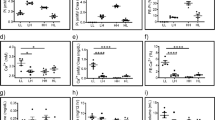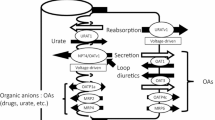Abstract
The role of four Pi transporters in the renal handling of Pi was analyzed using functional and molecular methods. The abundance of NaPi-IIa, NaPi-IIc, and Pit-2 was increased by 100% in kidney from rats on a 0.1% Pi diet, compared to a 0.6% Pi diet. Pit-1 was not modified. Type II-mediated Pi uptake in Xenopus oocytes increased as the pH of the uptake medium increased, and the opposite occurred with Pit-1 and Pit-2. At pH 6.0, Pi uptake mediated through type II was ≈10% of the uptake at pH 7.5, but the uptake through Pit-2 was 250% of the activity at pH 7.5. Real brush-border membrane vesicles (BBMV) responded to pH changes following the same pattern as type II transporters. Adaptation to a 0.1% Pi diet was accompanied by a 65% increase in the V max of BBMV Pi transport at pH 7.5, compared to a 0.6% Pi diet. The increase was only 11% at pH 6.0. Metabolic acidosis increased the expression of NaPi-IIc and Pit-2 in animals adapted to a low Pi diet, and phosphaturia was only observed in control diet animals. The combination of the pH effect, Pi adaptation, and metabolic acidosis suggests very modest involvement of Pit-2 in renal Pi handling. Real-time PCR and mathematical analyses of transport findings suggest that NaPi-IIa RNA accounts for 95% of all Pi transporters and that type II handles 97% of Pi transport at pH 7.5 and 60% of Pi transport at pH 6.0, depending on the pH and the physiological conditions.







Similar content being viewed by others
References
Ambühl PM, Zajicek HK, Wang H, Puttaparthi K, Levi M (1998) Regulation of renal phosphate transport by acute and chronic metabolic acidosis in the rat. Kidney Int 53:1288–1298
Bacconi A, Virkki LV, Biber J, Murer H, Forster IC (2005) Renouncing electroneutrality is not free of charge: switching on electrogenicity in a Na+-coupled phosphate cotransporter. Proc Natl Acad Sci USA 102:12606–12611
Beck L, Karaplis AC, Amizuka N, Hewson AS, Ozawa H, Tenenhouse HS (1998) Targeted inactivation of Npt2 in mice leads to severe renal phosphate wasting, hypercalciuria, and skeletal abnormalities. Proc Natl Acad Sci USA 95:5372–5377
Berndt T, Thomas LF, Craig TA, Sommer S, Li X, Bergstralh EJ, Kumar R (2007) Evidence for a signaling axis by which intestinal phosphate rapidly modulates renal phosphate reabsorption. Proc Natl Acad Sci USA 104:11085–11090
DuBose TD Jr, Pucacco LR, Seldin DW, Carter NW, Kokko JP (1979) Microelectrode determination of pH and PCO2 in rat proximal tubule after benzolamide: evidence for hydrogen ion secretion. Kidney Int 15:624–629
DuBose TD Jr, Pucacco LR, Lucci MS, Carter NW (1979) Micropuncture determination of pH, PCO 2, and total CO2 concentration in accessible structures of the rat renal cortex. J Clin Invest 64:476–482
Gold LW, Massry SG, Arieff AI, Coburn JW (1973) Renal bicarbonate wasting during phosphate depletion. A possible cause of altered acid-base homeostasis in hyperparathyroidism. J Clin Invest 52:2556–2562
Guntupalli J, Eby B, Lau K (1982) Mechanism for the phosphaturia of NH4Cl: dependence on acidemia but not on diet PO4 or PTH. Am J Physiol 242:F552–F560
Hruska KA (2008) Disorders of phosphate balance: hypophosphatemia & hyperphosphatemia. In: Lerma EV, Berns JS, Nissenson AR (eds) Current diagnosis & treatment. Nephrology & hypertension. McGraw Hill, New York, pp 69–78
Lemann J Jr, Bushinsky DA, Hamm LL (2003) Bone buffering of acid and base in humans. Am J Physiol Renal Physiol 285:F811–F832
Levi M, Lötscher M, Sorribas V, Custer M, Arar M, Kaissling B, Murer H, Biber J (1994) Cellular mechanisms of acute and chronic adaptation of rat renal P(i) transporter to alterations in dietary P(i). Am J Physiol 267:F900–F908
Magagnin S, Werner A, Markovich D, Sorribas V, Biber J, Murer H (1993) Expression cloning of human and rat renal cortex Na/Pi cotransport. Proc Natl Acad Sci USA 90:5979–5983
Moe OW (2009) PiT-2 coming out of the Pits. Am J Physiol Renal Physiol 296:F689–F690
Murer H, Hernando N, Forster I, Biber J (2000) Proximal tubular phosphate reabsorption: molecular mechanisms. Physiol Rev 80:1373–1409
Nowik M, Picard N, Stange G, Capuano P, Tenenhouse HS, Biber J, Murer H, Wagner CA (2008) Renal phosphaturia during metabolic acidosis revisited: molecular mechanisms for decreased renal phosphate reabsorption. Pflugers Arch 457:539–549
Pfister MF, Hilfiker H, Forgo J, Lederer E, Biber J, Murer H (1998) Cellular mechanisms involved in the acute adaptation of OK cell Na/Pi-cotransport to high- or low-Pi medium. Pflugers Arch 435:713–719
Prié D, Ureña Torres P, Friedlander G (2009) Latest findings in phosphate homeostasis. Kidney Int 75:882–889
Segawa H, Kaneko I, Takahashi A, Kuwahata M, Ito M, Ohkido I, Tatsumi S, Miyamoto K (2002) Growth-related renal type II Na/Pi cotransporter. J Biol Chem 277:19665–19672
Segawa H, Onitsuka A, Kuwahata M, Hanabusa E, Furutani J, Kaneko I, Tomoe Y, Aranami F, Matsumoto N, Ito M, Matsumoto M, Li M, Amizuka N, Miyamoto K (2009) Type IIc sodium-dependent phosphate transporter regulates calcium metabolism. J Am Soc Nephrol 20:104–113
Silverstein DM, Barac-Nieto M, Murer H, Spitzer A (1997) A putative growth-related renal Na+-Pi cotransporter. Am J Physiol 273:R928–R933
Villa-Bellosta R, Bogaert YE, Levi M, Sorribas V (2007) Characterization of phosphate transport in rat vascular smooth muscle cells: implications for vascular calcification. Arterioscler Thromb Vasc Biol 27:1030–1036
Villa-Bellosta R, Sorribas V (2008) Role of rat sodium/phosphate cotransporters in the cell membrane transport of arsenate. Toxicol Appl Pharmacol 232:125–134
Villa-Bellosta R, Barac-Nieto M, Breusegem SY, Barry NP, Levi M, Sorribas V (2008) Interactions of the growth-related, type IIc renal sodium/phosphate cotransporter with PDZ proteins. Kidney Int 73:456–464
Villa-Bellosta R, Ravera S, Sorribas V, Stange G, Levi M, Murer H, Biber J, Forster IC (2009) The Na+-Pi cotransporter PiT-2 (SLC20A2) is expressed in the apical membrane of rat renal proximal tubules and regulated by dietary Pi. Am J Physiol Renal Physiol 296:F691–F699
Villa-Bellosta R, Sorribas V (2009) Different effects of arsenate and phosphonoformate on Pi transport adaptation in opossum kidney (OK) cells. Am J Physiol Cell Physiol 297:C516–C525
Virkki LV, Biber J, Murer H, Forster IC (2007) Phosphate transporters: a tale of two solute carrier families. Am J Physiol Renal Physiol 293:F643–F654
Wagner C, Devuyst O, Bourgeois S, Mohebbi N (2009) Regulated acid–base transport in the collecting duct. Pflugers Arch 458:137–156
Acknowledgments
This work was supported by a grant from the Spanish Ministry of Education and Science (BFU2006-06284/BFI to VS) and a predoctoral fellowship from the Government of Aragón, Spain (B086/2007 to RVB).
Author information
Authors and Affiliations
Corresponding author
Rights and permissions
About this article
Cite this article
Villa-Bellosta, R., Sorribas, V. Compensatory regulation of the sodium/phosphate cotransporters NaPi-IIc (SCL34A3) and Pit-2 (SLC20A2) during Pi deprivation and acidosis. Pflugers Arch - Eur J Physiol 459, 499–508 (2010). https://doi.org/10.1007/s00424-009-0746-z
Received:
Revised:
Accepted:
Published:
Issue Date:
DOI: https://doi.org/10.1007/s00424-009-0746-z




